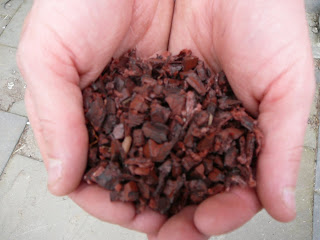Before you mulch: Mulch is the icing to the cake, there is some work to be done before you spread your mulch. Follow the steps below to achieve great results.
1. Kill Weeds - It is a good idea to spray all weeds with Round-Up or another weed killer 1 to 2 weeks prior to mulching. This will allow the weeds to completely die. Dead weeds are the best weeds to pull!
2. Trim Trees and Bushes - because of the debris produce, it is recommended that you trim your trees and bushes prior to mulching.
3. Clean Out Your Beds - clean out all dead leaves, weeds and trimmings with a rake. An adjustable rake works best.
4. Cultivate - after your beds have been cleaned, cultivate any compacted soil or mulch. A roto-tiller or hand cultivator will do the job. Cultivating will allow moisture and air to pass through the mulch easier.
5. Edge Your Beds - creating a clean edge really enhances your landscape and gives it a professional look. An edging shovel or power edger can be used to create your edge. Try using you garden hose as a guide to create nice flowing curves.
6. Rake Smooth - using a stiff rake, such as a mud rake, smooth out all the surfaces to be mulched. Otherwise, your mulch will look lumpy.
7. Apply a Pre-Emergent - now is the time to apply one such as Preen, to prevent germination of weed seeds. A second application, after the mulch has been installed, can add protection from weed seeds the may germinate in the mulch.
8. It's Time To Mulch - using your hands or a rake, apply new mulch over the existing cultivated mulch or soil to a total of 2 inches thick. When complete, water to moisturize mulch and settle it into place.
9. Mulch maintenance - after a month or so, check your mulch for compaction. If compacted, use a garden claw, rake, or cultivator to loosen (scratch) it. This will allow water and air to pass, which helps prevent the growth of fungus and restores appearance.
10. Fungus - if present, remove it with the surrounding mulch. Rake existing mulch to cover the area, then water thoroughly. Fungus is a sure sigh that your mulch has compacted and your beds have dehydrated, cultivation and watering will be necessary.
Why Mulch?
Mulch has a number of benefits for the garden. HereÕs why gardeners use it.
Appearance - Mulch makes a bed look neat and orderly.
Moisture - Mulch helps retain water in beds.
Weeds - Mulch serves as a barrier to prevent seeds from germinating.
Enrichment - Mulch provides nutrients, especially nitrogen, to the soil.
Erosion - Mulch helps anchor soil on a slope.
Protection - Mulch buffers plants and trees from lawn equipment.
Insulation - Mulch helps keep soil temperature extremes.
How much do I need?
We recommend you mulch 3 inches deep. At this depth, one cubic yard covers approximately 100 square feet. Multiply the length and width (in feet) of your coverage area, divide that number by 100 and this will be how many cubic yards you need. Please visit our Mulch Calculator. How Many Bags Equals a Cubic Yard?
There are 13 1/2 two cubic foot bags or 9 three cubic foot bags to one cubic yard.
How Many Yards Will My Truck Hold?
Full size pickups will hold 2-3 cubic yards. A small pickup will hold approximately 1-11/2 cubic Yards.
Does Mulch Attract Termites?
This is the number one question asked. The answer is NO. Please visit this Web site to learn more about mulch and termites. Click Here Is Your Mulch Treated?
No, we do not treat our mulches with any chemicals.
What is this Mold on Top of the Mulch?
When we get a hot and humid summer a fungus sometimes grows on top of the mulch. It looks like vomit or spew. Most funguses occur where there is a lot of shade and very little air movement. The mold can easily be cleared off by tossing it with a shovel. Dyed and hardwood mulches compact causing a dry condition under the mulch. When this occurs, your landscape will be starved of water and air. This will promote the growth of fungus and will raise soil temperatures through the summer months. Occasional aerating, cultivating (raking) and watering will greatly decrease the chance of fungus and disease. The finer and dryer the mulch, the more prone it is to this problem.
Pine Needles or Cypress mulch do not produce fungus. How Often Will I Need to Mulch?
This will depend on what type of mulch you use and how fresh you like your landscape to look. To keep “Bark” mulches looking fresh you will need to mulch once every year since they tend to break down quicker enriching your soil below. Colored Dyed Mulches will fade after a year, so to keep them looking good you may need to apply a new layer once a year. Cypress, Cedar, and Pine last longer and may need top dressed every so often. Pine Needles last a long time and you may experience several years between mulching.
http://www.indianamulch.com/
CHECK OUT OUR RATING
VOTE US #1












